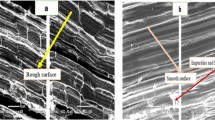Abstract
Burning rice straw particles is a problem for generating atmospheric particulate matter (PM2.5) in Thailand. Increase in value-added rice straw such as production of rice straw particle board is an attractively promising product. The prevulcanized natural rubber-bonded rice straw particles using bis-(3-triethoxysilylpropyl)tetra sulphide (Si-69) acting as silane coupling agents were used to produce rice straw particle board. The effect of Si-69 concentrations of 2, 5, 7, and 10%w/v on the properties of rice straw particle board was investigated. The surfaces of treated rice straw particles were characterized by attenuated total reflectance Fourier transform infrared spectroscopy (ATR-FTIR), and X-ray photoelectron spectroscopy (XPS). In addition, modulus of rupture (MOR), modulus of elasticity (MOE), internal bonding (IB) thickness swelling (TS) and water absorption (WA) of the prepared samples were measured. The result illustrated that the rice straw particle board was successfully manufactured using prevulcanized natural rubber and Si-69 coupling agent. The rice straw surface was fully covered by Si-69 and the amount of silicon and sulphur elements were increased with increasing Si-69 concentration. Consequently, the IB, MOR and MOE of the rice straw particle tended to increase with increasing Si-69 concentration. This is possibly due to good interfacial adhesion and reasonable stress transfer between rice straw particles and prevulcanized natural rubber as well as higher crosslink density of prevulcanized natural rubber. On the other hand, TS and WA of the rice straw particle were sharply decreased with increasing Si-69 concentration because the rice straw surface may be partially covered by the hydrophobic parts of Si-69.







Similar content being viewed by others
References
Maneepitaka S, Ullahb H, Dattab A (2019) Effect of water and rice straw management practices on yield and water productivity of irrigated lowland rice in the Central Plain of Thailand. Agriculture 211:89–97
Phairuang W, Suwattiga P (2019) The influence of the open burning of agricultural biomass and forest fires in Thailand on the carbonaceous components in size-fractionated particles. Environ Pollut 247:238–247
Pan M, Yu L, Gan X (2017) Structural analysis and transformation of biosilica during lignocellulose fractionation of rice straw. J Mol 1127:575–582
Kurokochi Y, Sato M (2015) Effect of surface structure, wax and silica on the properties of binderless board made from rice straw. Ind Crops Prod 77:949–953
Kurokochi Y, Sato M (2015) Properties of binderless board made from rice straw: the morphological effect of particles. Ind Crops Prod 69:55–59
Li X, Cai Z, Winandy Jerrold E, Basta Altaf H (2010) Selected properties of particleboard panels manufactured from rice straws of different geometries. Bioresour Technol 101:4662–4666
Han G, Umemura K, Kawai S, Kajita H (1999) Improvement mechanism of bondability in UF-bonded reed and wheat straw boards by silane coupling agent and extraction treatments. J Wood Sci 45:299–305
Li X, Cai Z, Winandy Jerrold E, Basta Altaf H (2011) Effect of oxalic acid and steam pretreatment on the primary properties of UF-bonded rice straw particleboards. Ind Crops Prod 33:665–669
Zhao Y, Qiu J, Feng H, Zhang M (2012) The interfacial modification of rice straw fiber reinforced poly(butylene succinate) composites: effect of aminosilane with different alkoxy groups. J Appl Polym 125:3211–3220
Ismail MR, Yassene AAM (2012) Effect of silane coupling agents on rice straw fiber/polymer composites. Appl Compos Mater 19:409–425
Tayfun U, Dogan M, Bayramli E (2016) Effect of surface modification of rice straw on mechanical and flow properties of TPU-based green composites. Polym Compos. https://doi.org/10.1002/pc.23331
Ferdosian F, Pan Z, Gao G, Zhao B (2020) Bio-based adhesives and evaluation for wood composites application. Polymers. https://doi.org/10.3390/polym9020070
Sitza Evan D, Bajwaa Dilpreet S, Websterb Dean C (2017) Epoxidized sucrose soyate—a novel green resin for crop straw based low density fiberboards. Ind Crops Prod 107:400–408
Radabutra S, Khemthong P, Saengsuwan S, Sangya S (2020) Preparation and characterization of natural rubber bio-based wood adhesive: effect of total solid content, viscosity, and storage time. Polym Bull 77:2737–2747
Nimpaiboon A, Sakdapipanich J (2020) Compatibility enhancement of silica and natural rubber compound using UVA-induced silane-grafted saponified skim natural rubber. J Polym Res. https://doi.org/10.1007/s10965-017-1420-3
Onchoy N, Phinyocheep P (2016) Preparation and characterization of brominated natural rubber applied in siica-filled natural rubber vulcanizates. Rubber Chem Technol 89:406–418
Brinke JW, Debnath SC, Reuvekamp LAEM, Noordermeer JWM (2003) Mechanistic aspects of the role of coupling agents in silica–rubber composites. Compos Sci Technol 63:1165–1174
Sae-ouia P, Sirisinha C (2005) Comparison of reinforcing efficiency between Si-69 and Si-264 in an efficient vulcanization system. Polym Test 24:439–446
Li F-h, Hu H-j (2012) Structure and saccharification of rice straw pretreated with microwave-assisted dilute lye. Ind Eng Chem Res 51:6270–6274
Sae-ouia P, Sirisinha C (2006) Roles of silane coupling agents on properties of silica-filled polychloroprene. Eur Polym J 42:479–486
Nunna S, Chandra PR, Shrivastava S, Jalan A (2012) A review on mechanical behavior of natural fiber based hybrid composites. J Reinf Plast Compos 31(11):759–769
Acknowledgements
Financial support from the Center of Excellence for Innovation in Chemistry (PERCH-CIC), Ministry of Higher Education, Science, Research and Innovation, and Thailand and National Science and Technology Development Agency (NSTDA) are gratefully acknowledged.
Author information
Authors and Affiliations
Corresponding author
Ethics declarations
Conflict of interest
No potential conflict of interest was reported by the authors.
Additional information
Publisher's Note
Springer Nature remains neutral with regard to jurisdictional claims in published maps and institutional affiliations.
Rights and permissions
About this article
Cite this article
Radabutra, S., Khemthong, P. & Saengsuwan, S. Effect of silane coupling agent pretreatment on the properties of rice straw particleboard bonded with prevulcanized natural rubber latex. J Rubber Res 24, 157–163 (2021). https://doi.org/10.1007/s42464-021-00081-z
Received:
Accepted:
Published:
Issue Date:
DOI: https://doi.org/10.1007/s42464-021-00081-z




